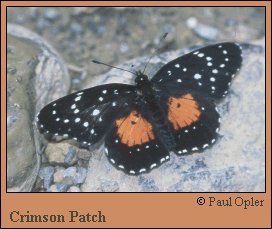 |
 

 |



Crimson Patch (Chlosyne janais [Drury])
Wing span: 1 7/8 - 2 5/8 inches (4.8 - 6.7 cm).
Identification: Upper and lower sides of forewing are black with small white spots. Upper hindwing is black with large orange-red patch on the basal half. Lower side of hindwing has an orange-red postmedian band that does not extend to margins of the wing.
Life history: Eggs are laid in groups under host plant leaves. Caterpillars feed on the undersides of leaves; younger caterpillars feed gregariously.
Flight: Several broods in South Texas from July-November, all year in the tropics.
Caterpillar hosts: Scrubby plants in the acanthus family (Acanthaceae) including Anisacanthus wrightii in Texas.
Adult food: Flower nectar.
Habitat: Lowland tropical forest edges and fields.
Range: Colombia north through Central America and Mexico to South Texas. Strays to north Texas and southeastern New Mexico.
Conservation: Not necessary for sporadic resident.
The Nature Conservancy Global Rank: G5 - Demonstrably secure globally, though it may be quite rare in parts of its range, especially at the periphery.
Management needs: Provide host plant patches in refuges and parks along the lower Rio Grande Valley, Texas.
References:
Opler, P. A. and V. Malikul. 1992. A field guide to eastern butterflies. Peterson
field guide #4. Houghton-Mifflin Co., Boston. 396 pages, 48 color plates.
Scott, J. A. 1986. The butterflies of North America. Stanford University Press,
Stanford, Calif. 583 pages, 64 color plates.
Author: Jane M. Struttmann

